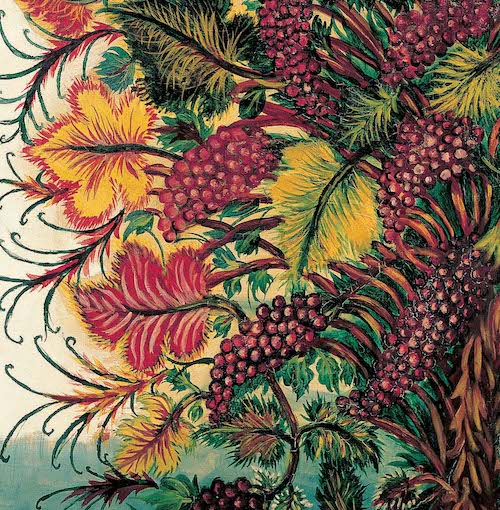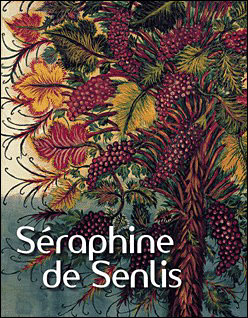En cours
A Venir
Billetterie
Collections en ligne
Actualités
Boutique
Restaurants et privatisation


It was customary during the Renaissance to refer to an artist by the name of the town or village of origin; for example, Antonello da Messina or Leonardo da Vinci. Séraphine joined this tradition at the dawn of the 20th century, becoming Séraphine de Senlis or simply Séraphine when the name was shortened.
Born into a modest family, she was consumed by the desire to paint; that famous inner need that Kandinsky spoke of for any artist overcome by the true creative urge. In Senlis, a town steeped in the Gothic period, the German aesthete and collector Wilhelm Uhde discovered Séraphine’s talent. At the time Séraphine had been working as his housekeeper. Uhde was astounded by the power, scale and, above all, intensity of the artist’s floral compositions.
Although Séraphine is commonly regarded as a key player in the movement of primitive painters, Uhde saw in her works the expression of modern primitivism: the power to represent the world of the unconscious, free from any school, academic technique, or formal affiliation.
Séraphine was self-taught. She hand made her own colors and kept her painting secret. Torn between a pathological need to create art and the fire of her spirit, Séraphine was haunted by images inspired by the illuminated rose window of Senlis Cathedral. Just as the people of the High Middle Ages who fell in adoration before the clarity of colors and images, Séraphine harnessed the fire that inflamed the psyche of entire generations in her paintings .
This was one of the dimensions of her art that fascinated Uhde. He had seen in the paintings of Douanier Rousseau, a talent he had also discovered, the same force of expression that he found in Séraphine. Uhde organized exhibitions for her and made her a part of the history of modern painting. In 1934, Séraphine fell into a psychosis and was interned until her death in 1942.
It was customary during the Renaissance to refer to an artist by the name of the town or village of origin; for example, Antonello da Messina or Leonardo da Vinci. Séraphine joined this tradition at the dawn of the 20th century, becoming Séraphine de Senlis or simply Séraphine when the name was shortened.
Born into a modest family, she was consumed by the desire to paint; that famous inner need that Kandinsky spoke of for any artist overcome by the true creative urge. In Senlis, a town steeped in the Gothic period, the German aesthete and collector Wilhelm Uhde discovered Séraphine’s talent. At the time Séraphine had been working as his housekeeper. Uhde was astounded by the power, scale and, above all, intensity of the artist’s floral compositions.
Although Séraphine is commonly regarded as a key player in the movement of primitive painters, Uhde saw in her works the expression of modern primitivism: the power to represent the world of the unconscious, free from any school, academic technique, or formal affiliation.
Séraphine was self-taught. She hand made her own colors and kept her painting secret. Torn between a pathological need to create art and the fire of her spirit, Séraphine was haunted by images inspired by the illuminated rose window of Senlis Cathedral. Just as the people of the High Middle Ages who fell in adoration before the clarity of colors and images, Séraphine harnessed the fire that inflamed the psyche of entire generations in her paintings .
This was one of the dimensions of her art that fascinated Uhde. He had seen in the paintings of Douanier Rousseau, a talent he had also discovered, the same force of expression that he found in Séraphine. Uhde organized exhibitions for her and made her a part of the history of modern painting. In 1934, Séraphine fell into a psychosis and was interned until her death in 1942.

Seraphine
de Senlis
It was customary during the Renaissance to refer to an artist by the name of the town or village of origin; for example, Antonello da Messina or Leonardo da Vinci. Séraphine joined this tradition at the dawn of the 20th century, becoming Séraphine de Senlis or simply Séraphine when the name was shortened.
Born into a modest family, she was consumed by the desire to paint; that famous inner need that Kandinsky spoke of for any artist overcome by the true creative urge. In Senlis, a town steeped in the Gothic period, the German aesthete and collector Wilhelm Uhde discovered Séraphine’s talent. At the time Séraphine had been working as his housekeeper. Uhde was astounded by the power, scale and, above all, intensity of the artist’s floral compositions.
Although Séraphine is commonly regarded as a key player in the movement of primitive painters, Uhde saw in her works the expression of modern primitivism: the power to represent the world of the unconscious, free from any school, academic technique, or formal affiliation.
Séraphine was self-taught. She hand made her own colors and kept her painting secret. Torn between a pathological need to create art and the fire of her spirit, Séraphine was haunted by images inspired by the illuminated rose window of Senlis Cathedral. Just as the people of the High Middle Ages who fell in adoration before the clarity of colors and images, Séraphine harnessed the fire that inflamed the psyche of entire generations in her paintings .
This was one of the dimensions of her art that fascinated Uhde. He had seen in the paintings of Douanier Rousseau, a talent he had also discovered, the same force of expression that he found in Séraphine. Uhde organized exhibitions for her and made her a part of the history of modern painting. In 1934, Séraphine fell into a psychosis and was interned until her death in 1942.
Mentions légales | CGU | Données personnelles | Gestion des cookies
Musée Maillol, 2021
Mentions légales | CGU | Données personnelles | Gestion des cookies
Musée Maillol, 2021